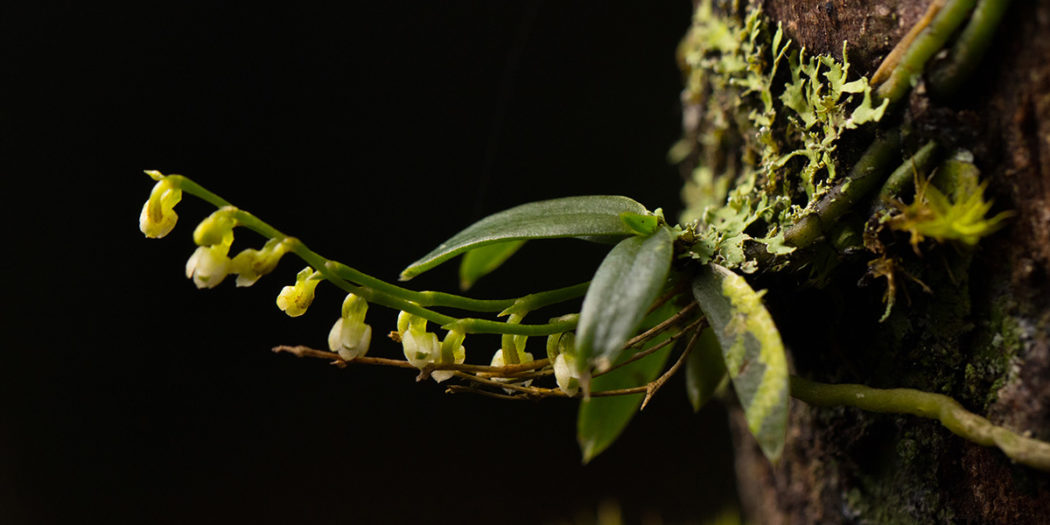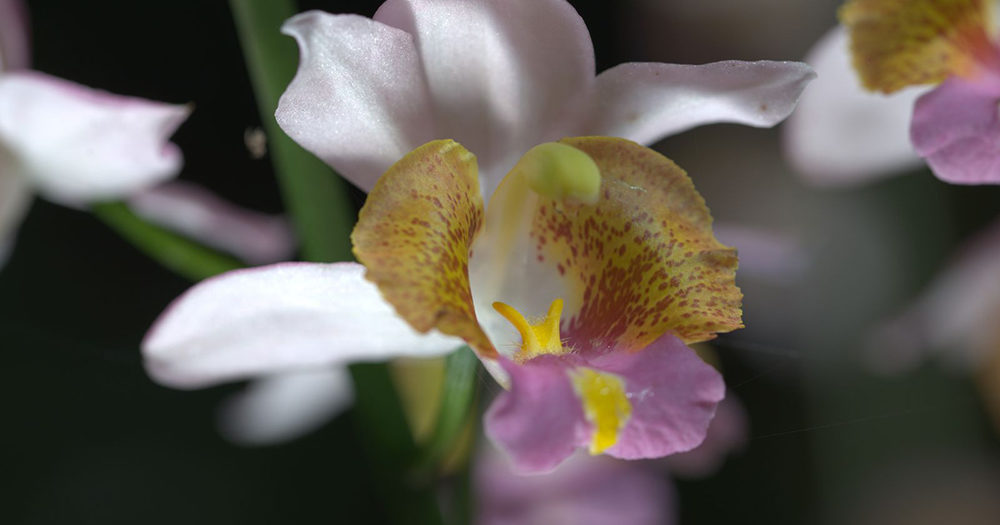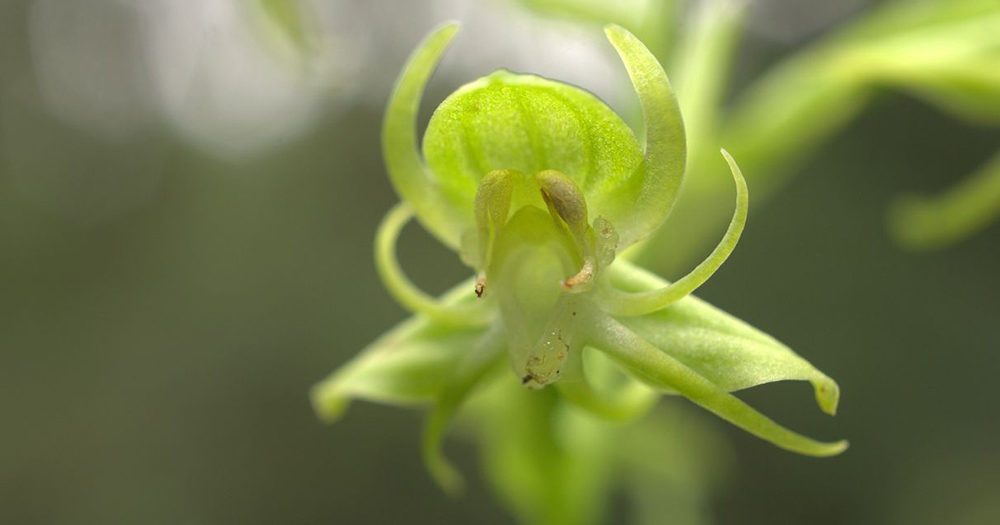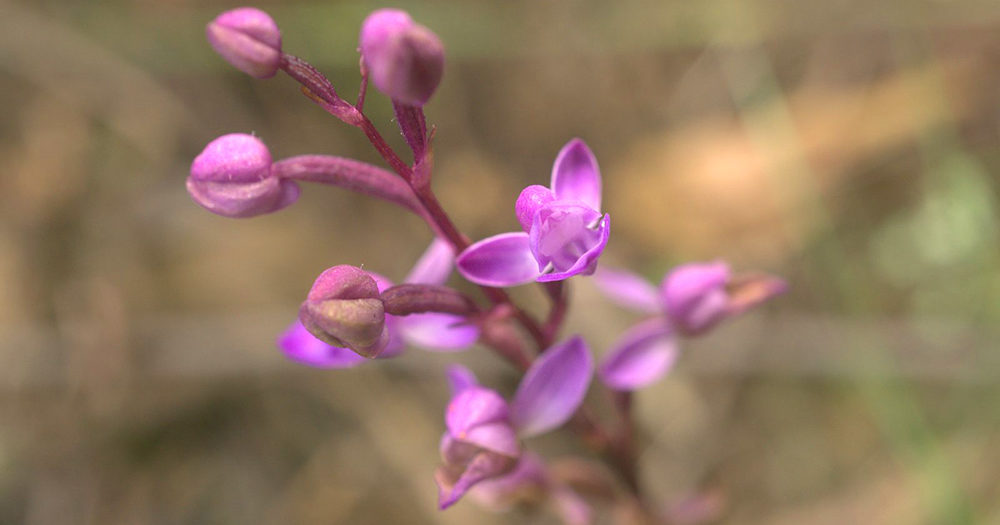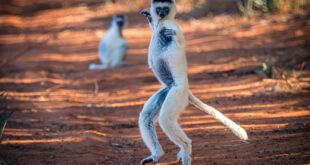Madagascar, the tropical island in the Indian Ocean, is better known as the land of baobabs. In fact, Madagascar is also a paradise for orchids. Currently, over 1000 different species are described from the island, over 90% of which are endemic, i.e. only found on Madagascar. The name orchid, by the way, has a less than praiseworthy origin. It comes from the Greek word όρχις orchis for testicle. The philosopher Theophrastus of Eresos had named the orchids so because the two round root tubers reminded him of human testicles.
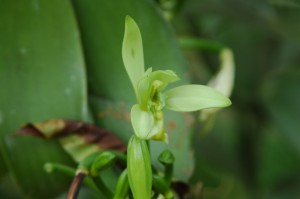
But back to the beautiful sides! Orchids are mainly known for their beautiful flowers: that’s why they are also called the Queens of Flowers. The flowers consist of petals, sepals, and the labellum, the lip. The lip functions as a landing platform for pollinators. In addition, orchids have so-called pollinia instead of individual pollen. These are two sticky pollen packets. They are stuck on insects when they visit the flower. The insects then use them to pollinate other orchids. But it is not only insects that ensure successful pollination. Depending on the species, ants, beetles, flies, bees, butterflies, birds or even frogs can also help individual orchids to reproduce. For many Malagasy orchids, it has not even been researched who pollinates them or how they reproduce. Some species can reproduce by means of tubers or filaments.
Only two genera of Malagasy orchids grow like climbing plants: Vanilla and Galeola. The island is home to seven different vanilla plants, including the spice vanilla (Vanilla planifolia). The latter grows particularly well in Madagascar. The northeast of the island is where most of the vanilla plantations are located. The city of Sambava is known as the “capital of vanilla”. By the way, vanilla is considered an aphrodisiac in Madagascar.
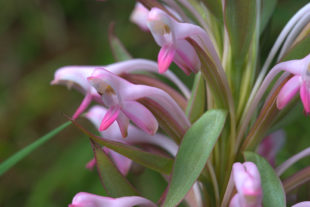
A very special way of life distinguishes the so-called saprophytic orchids from all others on Madagascar: they have no leaves and therefore cannot produce chlorophyll. These orchids depend on certain fungi, called mycorrhizae, on their roots. The fungi provide the flowers with the necessary nutrients. This group includes the genera Didymoplexis, Auxopus, Eulophia, Gastrodia, and the species Habenaria saprophytica, which is the only one of its genus capable of such a way of life and was named accordingly. It was not until 2020 that Gastrodia agnicellus was described from Ranomafana National Park. The orchid with the fleshy stem and tiny, brownish flowers became known as the “ugliest orchid in the world“.
A whole series of orchid genera on Madagascar grow terrestrially, i.e. on the ground. Some form tubers that sit under the earth. These root tubers ensure that the orchids can survive even long periods of drought. This is because orchids can be found in all kinds of habitats in Madagascar: In the always humid rainforest, in the dry forest, in the hot and dry thorn forest, on inselbergs in airy heights, near rice fields in the highlands, in ravines, between the Tsingys and in savannas. Root-knotted orchids include Satyrium, Disperis, Disa, Brownleea, Brachycorythis, Tylostigma, Benthamia, Habenaria, Megalorchis, Platycoryne, Physoceras, and Cynorkis. Certain Satyrium species are said to have particularly sweet nectar. The Souimanga Sunbird (Cinnyris sovimanga) is said to be particularly fond of these orchids with its long, narrow bill.
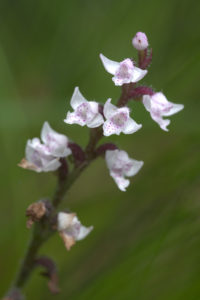
Then there are orchids in Madagascar that also grow on the ground. However, they have a rather fleshy rhizome creeping on the ground. If you see them for the first time, you might confuse some of these orchids with succulents. The flowers are small and rather inconspicuous, but the leaves are particularly pretty. These orchids include the genera Cheirostylis, Platylepis, Goodyera, and Zeuxine.
A third group of orchid genera also lives on the ground but forms a very hard and dry rhizome. This group includes Corymborkis, Nervilia, Calanthe, Gastrorchis, Phaius, Liparis, Malaxis, Imerinaea, Eulophia, and Oeceoclades, as well as the species Cymbidiella flabellata.
Another distinguishing feature among orchids is the inflorescences. The genera Polystachia, Liparis, Oberonia, and Agrostophyllum bear a so-called terminal flower. This means that their inflorescence is closed, i.e. it bears a flower at the uppermost part of the stem. This flower usually opens first on the orchid, followed by the other flowers.
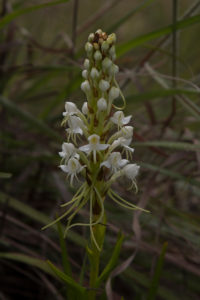
The genera Bulbophyllum, Graphorkis, Paralophia, Grammangis, Eulophiella, and Cymbidiella are the counterparts: These orchids have an open inflorescence. In this case, the uppermost flowers go off to the side of the stem, there is no flower at the end of the stem itself, only a somewhat tapered end. The above genera form pseudobulbs for this purpose. These are thickened areas in the lower part of the stem of the plant that serve as water and nutrient storage. They look like roots, but they are not – hence the name pseudobulbs.
Famous from the small dream island of Nosy Nato on the east coast of Madagascar is the “pink orchid” (French “orchidée rose”) Eulophiella roempleriana. This beautiful flower with its large, pinkish-white blossoms grows in the leaf axils of certain screw palms (Pandanus utilis). However, it blooms only during the most intense rainy season in December and January.
Around Antongil Bay and up to the central east coast grows a close relative of the pink orchid, Eulophiella elisabethae. The large, white flowers with pink hues and yellow lip bloom at the beginning of the rainy season, in November. The plant on which Eulophiella elisabethae grows is a palm tree, Dypsis fibrosa.
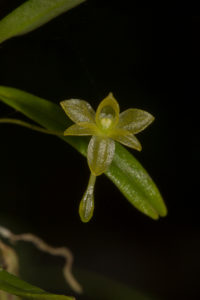
Similarly known is the black orchid, Cymbidiella falcigera. It grows on raphia palms (Raphia farinifera). However, its flowers are not completely black everywhere in Madagascar, only some color variants on the east coast have particularly dark petals. Between December and March, Cymbidiella falcigera can be found in the Akanin’ny Nofy reserve.
Much rarer than these two beauties, but no less magnificent is Grammangis spectabilis. It belongs to the rarest orchids of Madagascar and is found in the southwest of the island. SPiny forests and remnants of dry forest belong to its habitat, but sometimes it can be found on fig trees. Whoever gets to see this orchid can consider himself lucky.
Completely without pseudobulbs, but also with closed inflorescence grow the Malagasy genera Microcoelia, Acampe, Beclardia, Angraecopsis, Microterangis, Aerangis, Aeranthes, Erasanthe, Lemurorchis, Neobathiea, Jumellea, Angraecum, Pectinariella, Ambrella, Oeoniella, Sobennikoffia, Oeonia, Lemurella, and Cryptopus. Some of them grow epiphytically, which means they sit on other plants, such as trees. Others live litophytically. They are found only on rocks and stones. Among these is the orchid Microcoelia aphylla. Its name gives it away: this species does not bear true leaves, they are reduced to small scales. Even the flowers are very small and rather inconspicuous. All the better developed are the roots! It is also the roots that provide photosynthesis in Microcoelia species.
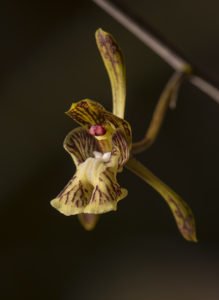
In the genera Aeranthes, Aerangis, and Angraecum, the lip is extended on the back to form a thin tube, the so-called spur. In it, very low down, is the nectar of the flower. The famous Darwin’s Orchid, Angraecum sesquipedale, has the longest spur of any orchid in the world, up to 45 cm. There is only one insect, a small moth, which has such a long proboscis that it can reach the sweet nectar. Quite a few orchids of the three genera secrete a sweet scent at night. This fragrance has earned them the name hanitriniala in Madagascar, meaning perfume of the forest.
Also worthy of note is the orchid Erasanthe henrici isaloensis. It is threatened with extinction, only a few dozen plants of the species should still exist. Its snow-white flowers open only in March. It can be found with luck in the gorges of the Isalo National Park.
In Madagascar, all orchids are basically protected. They may not be taken from nature unless you have an exemption and CITES certificates. Due to their partly very specialized habitats, many orchids on Madagascar are threatened. Their original habitat is getting smaller and smaller due to logging, slash and burn, and mines. If epiphytic orchids lack their plant or terrestrial their shade, they disappear. In addition, many orchids are sensitive to fertilizers and pesticides, so in proximity to agricultural land, can not grow. In addition, orchids are sometimes illegally collected, the international orchid trade is flourishing.
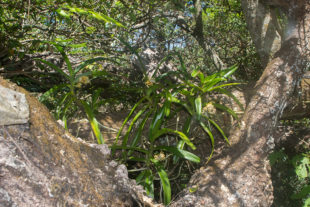
Despite the ongoing threat, new orchids are still being discovered in Madagascar almost every year. Countless species are still waiting to be discovered, even more to be scientifically described and named. If you go a little bit off the beaten track, you have a good chance to find some unknown orchid highlights on Madagascar.
So it is worth traveling to Madagascar! Especially for orchid lovers.
 MADAMAGAZINE Your Magazine about Madagascar
MADAMAGAZINE Your Magazine about Madagascar
